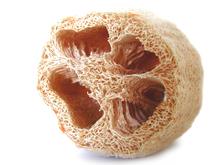Cucurbits
| Cucurbits | ||||||||||||
|---|---|---|---|---|---|---|---|---|---|---|---|---|

White bryony ( Bryonia alba ), illustration |
||||||||||||
| Systematics | ||||||||||||
|
||||||||||||
| Scientific name | ||||||||||||
| Cucurbitaceae | ||||||||||||
| Yuss. |
The cucurbits (Cucurbitaceae) are a family of flowering plants (Magnoliopsida). The representatives are mostly herbaceous plants with tendrils , unisexual flowers and ovary below . The corolla is mostly fused, the stamens are interconnected or fused.
The cucurbits are a medium-sized family and comprise around 800 species in around 130 genera , which are divided into the two subfamilies Nhandiroboideae and Cucurbitoideae. They are represented worldwide in the tropical and subtropical climatic zones , only a few species also occur in temperate areas; in Central Europe about only genus that is fence beet ( Bryonia ) at home. The couple have a number of crops that are commercially important vegetable marrow ( Cucurbita pepo ), melon ( Cucumis melo ), cucumber ( Cucumis sativus ) and watermelon ( Citrullus lanatus ).
description
Roots and storage organs
Most representatives have a pronounced taproot , which is one meter in the case of cucumber ( Cucumis sativus ) and two meters in the case of pumpkins ( Cucurbita ). Near the surface, they form a dense network of lateral roots that cover at least as large, if not larger, floor area than the organs above ground. Adventive roots are often formed on horizontal shoot axes , even without direct contact between the shoot axis and the ground.
Some xerophytic representatives form storage roots with which they survive dry periods. In Acanthosicyos they reach up to 15 meters deep.
Shoot axis and tendrils
The shoot axes are herbaceous, rarely also slightly woody. Mostly they are lying down, creeping or climbing. They are often angular in cross-section and have a hollow center. The side branches of the first and second order can be up to 15 meters long. Pumpkins have shrub-like shapes with short internodes .

The vascular bundles are bicollateral, that is, the phloem is located inside and outside the xylem . Usually there are ten vascular bundles, which are arranged in two rings around the central cavity. The sieve tubes are relatively large and in some clans are also scattered in the bark and thus connect the individual vascular bundles.
Many representatives are soft or coarsely hairy on the stem as well as on the leaves, only a few are hairless. The shape of the trichomes is very variable: they can be glandular, single or multicellular, simple or branched.
In a number of unrelated clans within the family, thick trunks are formed as storage organs ( pachycaulia ). Pachycaule representatives in the subfamily Nhandiroboideae are Gerrardanthus , Neoalsomitra , Xerosicyos and Zygosicyos . Within the subfamily Cucurbitoideae in the tribe Benincaseae Cephalopentandra , Coccinia , Trochomeria , in the tribe Coniandreae Corallocarpus , Doyerea , Ibervillea , Kedrostis , Seyrigia , as well as scattered Marah , Sinobaijiana , Momordica , Odosicyraos and Tricycland . The most extreme representative is Dendrosicyos .
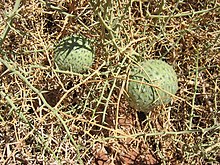
The tendrils are modified shoot axes and the clearest derived characteristic of the family. They occur in all but a few highly modified, woody species. In some of these species ( Acanthosicyos horridus , Acanthosicyos naudiana ) they are transformed into thorns , in others ( Citrullus ecirrhosus , Dendrosicyos socotranus , Ecballium elaterium , Melancium campestre , Myrmecosicyos messorius and Trochomeria polymorpha ) they are completely absent. A distinction is usually made between three types of tendrils:
- The cucumber ( Cucumis sativus ) has simple, unbranched tendrils .
- branched tendrils, the lower part of which is insensitive to touch and does not curl up. The tendrils can have up to eight side tendrils. This type is mainly represented in the Cucurbitoideae. Some species have developed disc-shaped adhesive organs similar to those of the maiden vines ( Parthenocissus ), such as Alsomitra macrocarpa , Neoalsomitra sarcophylla or Trichosanthes cucumerina .
- branched tendrils, the lower part of which curls up, also called zaninoid tendrils. This type occurs mainly in the tribe Zanonieae (= subfamily Nhandiroboideae ) and some basic representatives of the subfamily Cucurbitoideae.
In some species, so-called probracts are formed. These are often sloping or permanent bract-like or leaf-like and often glandular structures on the inflorescence or flower stalk or, more rarely, on sterile nodes or leaf nodes.
leaves
The leaves are arranged alternately on the stem axis in a screw with 2/5 phyllotaxis . Foliage leaves are divided into petiole and leaf blade. In the petiole the vascular bundles are arranged in a crescent or ring shape. The vascular bundles are unequal, the larger ones are bicollateral. The leaf blades are simple and slightly lobed to deep three to seven times palmate. The vein is also palmate. Succulent leaves are rare, even among the xerophytic species. Xerosicyos has large water-storing cells in the mesophyll and is a CAM plant . With most representatives in dry and hot areas, heat damage to the leaves is prevented by high transpiration rates . Some species have extra-floral nectaries on the leaves . Stipules are usually absent. In Acanthosicyos stipules are present and converted into photosynthetically active thorns.
The stomata are predominantly anomocytic, they lack the accompanying cells.
blossoms
The flowers of most representatives are large and showy and are pollinated by insects . Some genera such as Echinocystis and Sechium produce small, inconspicuous flowers. The flowers of all representatives are in the leaf axils, either individually or in inflorescences . Common colors are white and yellow, other colors such as red in Gurania are less common .
The flowers are mostly unisexual, so they have either male or female organs. The flower systems are each hermaphroditic, but only the male or female organ systems develop further. In the male (staminate) flower a stamp rudiment (pestillodium) is often preserved, in the female stamen rudiments (staminodes) can occur. The plants are monoecious (both sexes on a plant) or dioecious (only one sex on a plant) depending on the species or genus . Of the approximately 800 species, around 460 are monoecious and 340 are dioecious. Further, rare gender distributions are discussed below.
The flowers have a pronounced "false" flower cup (hypanthium), which is cup-shaped to bell-shaped and is formed from the flower axis and / or from the overgrown basal parts of the calyx and crown (calyx-crown beaker). The flowers are usually five-fold. The two circles of the double flower envelope usually consist of five, rarely between three and six, petals each. The sepals are more or less fused. The petals are free or fused, mostly radial symmetry and form a wheel- or bell-shaped crown.
The stamens are monothecic (have only one theca ), attach to the hypanthium and alternate with the petals. The basic number of stamens is five. Some genera like Fevillea have five free stamens, in some all stamens are fused like in Cyclanthera . Other genera such as cucumbers ( Cucumis ) have two overgrown pairs and a free stamen, giving the impression of three stamens. These three are mostly connected to one another via their anthers .
The ovary is usually inferior or (epiperigyn), the perianth has a short to long "epigynum zone" which bears the chalice. It usually consists of three fused carpels , rarely one to five. The number of styles is strongly conserved: in the Nhandiroboideae they are always free and usually three in number, rarely two. The Cucurbitoideae have a style with two, three or five stigmas . These are usually enlarged and often resemble the stamens, probably to attract pollinators. The ovary is not divided into compartments, the partition walls are dissolved and the placentas , on which the ovules are located, are on the pericarp ( parietal ). In the Nhandiroboideae the number of ovules is usually small, the ovules are always drooping . The Cucurbitoideae usually have large placentas with sometimes very many ovules, but Sechium edule only one. These are usually upright or horizontal, rarely hanging. The ovules in the whole family are crassinucellate, anatropic, and bitegmic . The nucellus is bottle-shaped, which is a characteristic of the family. The embryo sac develops according to the polygonum type.
The flowers often, but not always, have nectaries , which attract pollinating insects. You are at the base of the hypanthium. In female flowers the nectarium forms a continuous ring around the base of the pistil , while in the male flowers it often forms a button-like hill in the center of the flower together with the pistillodium.
Pollen
The pollen grains are quite diverse within the family. The aperture can be tri- to multiple zonocolpat, colporat, tri- to multiple porat or pantoporat. The surface of the exine is reticulated, regularly granulated or provided with spikes.
The pollen is spread out in the form of single grains, more rarely in pollen tetrads. The Nhandiroboideae always have tricolpate pollen grains with a diameter of less than 40 micrometers. Their outer layer (exine) is usually striped (striat), rarely reticulated (reticulate). The Cucurbitoideae have unusually large pollen grains of up to 200 micrometers, the exine is reticulate or prickly (echinat), the apertures are porate or colpat. Two tribes can be identified by the pollen grains: the Cucurbiteae have echinate pollen grains that have three to many germ pores (triporate to stephanoporate); the Sicyeae have finely prickly pollen grains with germinal folds (colpat) or mixed pores / folds (colporat). In the remaining shoots, tricolor pollen grains predominate.
Fruits and seeds
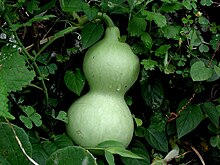
The fruits are often non-opening berries , often with a hard shell, so-called armored berries, more rarely opening berries or capsule fruits are formed, stone fruits or wing nuts are very rare . Shape and surface are very variable. They are spherical to elongated. The bottle gourds ( Lagenaria ) are round, pear-, bottle-shaped or oblong. The surface of pumpkins can be striped, spotted or monochrome, the surface smooth, wrinkled or warty. The fruits of the giant pumpkin ( Cucurbita maxima ) are the largest in the plant kingdom: on September 29, 2007, a 766 kg pumpkin was weighed in Massachusetts . Most species with tank berries are native to seasonally dry areas: here the hard-skinned, water-storing fruits allow the seeds a longer ripening period, even when the rest of the mother plant has already wilted. Most remain closed at maturity. In the genera Momordica and Cyclanthera , the fruits open. The fruit of the bryony ( Bryonia ) are about five millimeters large, round and green, red or black.
In the case of the squirt cucumber ( Ecballium elaterium ) and the exploding cucumber ( Cyclanthera brachystachya ), the fruits detach from the stalk and explosively expel the pressurized interior. Cucumis humifructus hides the flowers after fertilization in the earth (geocarpy), where the fruits ripen and are dug up and consumed by the aardvark ( Orycteropus afer ), which spreads the seeds. The American genus Apatzingania also has geocarpic fruits.
In the case of the Nhandirobideae, capsule fruits predominantly occur, which release winged seeds.

The seeds are usually too many, often in hundreds, in one fruit, very rarely is only one per fruit. The seeds are mostly flat, in rare cases winged. There is a collapsed perisperm under the seed coat . An endosperm is missing or scarce. The embryo is very oil-rich, its two cotyledons fill most of the seed.
Size, shape and color are very diverse. The largest wingless "casts" forms Hodgsonia up 8.5 centimeters in length, the smallest the bryony ( Bryonia ) with sometimes only three millimeters in diameter.
Cytology and genetics
The predominant basic chromosome number is x = 12, but it ranges from 7 to 24. The Cucurbiteae have a fixed polyploidy with a chromosome set of n = 20. Polyploidy and aneuploidy are also quite common in other tribes . The entire family is characterized by a 35 base pair long inversion in the area between the genes for leucine - tRNA and phenylalanine - tRNA , which does not occur in the other families of the order Cucurbitales, i.e. represents a synapomorphism . In Cucurbita digitata and Neoalsomitra this inversion has been reversed again - independently of one another.
The genome of the Cucurbitaceae is unusually labile compared to other families. There are two of the six known cases in which the otherwise plastid gene rbc L (for the large subunit of RuBisCO ) is transferred into the mitochondria genome: in cucumbers ( Cucumis sativus ) and in pumpkins ( Cucurbita pepo , Cucurbita maxima ), but independently of each other.
The genus Cucumis also has the largest known mitochondrial genomes, which are 1500 kb in cucumber and 2400 kb in sugar melon ( Cucumis melo ). In both types, mitochondrial inheritance takes place via the father (paternal), not, as is usual, via the mother.
ingredients
The most characteristic ingredients for the family are the bitter substances from the group of cucurbitacins . These are tetracyclic triterpenes and occur glycosylated or as aglycones . They are mainly found in the fruits, with the exception of cultivated forms that have been selected for low bitterness. Seeds are always free from cucurbitacin.
In addition to the cucurbitacins, there are also bitter triterpene saponins which are based on the basic structures dammaran , cucurbitan and lanostan . The genera Luffa and Trichosanthes are particularly rich in saponins .
The seeds are generally rich in oils . In the commercially used species, the oil content varies between 38 and 45 percent. The most common fatty acids are palmitic acid , stearic acid , oleic acid , linoleic acid, and linolenic acid , which together make up more than 80 percent of fatty acids. In addition, are phosphatidylcholine , Lysophosphatidyl- ethanolamine , phosphatidyl inositol , and phosphatidylethanolamine , sterol glycosides, cerebroside and Diphosphatidyl- glycerol frequently. In Trichosanthes TYPES is punicic , a conjugated triene acid, often in α- Momordica eleostearic . In total, more than 150 fatty acids have been identified in the seeds of the cucurbits.
Various non-proteinogenic amino acids , especially citrulline, occur in seeds and fruits . The storage proteins in the seeds are mainly globulins .
In the phloem the cucurbits transport not only sucrose but also the representatives of the raffinose family as carbohydrates , which is why they are counted among the symplastic phloem loaders .

Growth and development
In some species, such as chayote ( Sechium edule ), seeds can already germinate in the fruit ( viviparia ). In many species there is a seed dormancy , which is broken by a few weeks in cool temperatures. For germination , darkness and high temperatures (usually 25 to 30 ° C) are necessary. Germination takes place epigeously, which means that the cotyledons are photosynthetically active. They are mostly elliptical.
Pumpkins grow very quickly at high temperatures. A wild specimen of Cucurbita foetidissima formed 360 rungs in one season in a circle of 12 meters radius and a total length of 2000 meters. The bottle gourd grows up to 60 centimeters in 24 hours. In large-fruited, climbing plants, the leaf area grows exponentially up to the point at which the fruit is set.
Sex determination
The sexuality of the cucurbits is extremely diverse and partly varies within a species. The original gender distribution within the family is dioeciousness ( diocyte ). Monocy and other forms are derived from it. Androdioceus (male plants and hermaphrodite plants) is extremely rare in plants, such as Schizopepon bryoniifolius . In the pumpkin family, hermaphrodite flowers, which are known only from a few varieties of useful plants, such as 'Satputia' from the sponge gourd Luffa acutangula, are extremely rare .
In the few species studied, the sex distribution is controlled by one or two genes, each of which has two or three alleles . Depending on the allele combination, there are, for example, with Luffa acutangula monoecious, andromoecan (male and hermaphrodite flowers), androecan (male only), gynomonic (female and hermaphrodite), gynecological (only female flowers) and hermaphrodite individuals. In some species, individuals change their sex in the course of their development, for example in Gurania .
In the genera Coccinia and Trichosanthes there are sex chromosomes , some of which are heteromorphic , which determine the sex of the individual plants. In Coccinia grandis , similar to humans, individuals with two X chromosomes are female. The larger Y chromosome determines the male gender and dominates, so that tetraploid individuals with three X and one Y chromosomes are also male.
The formation of the sex is not only subject to genetic regulation, but is also influenced by the hormonal balance, the length of the day and temperature. Male flowers are encouraged at high temperatures and female flowers at low temperatures. Short day conditions (eight hours of light) often encourage female flowers. Generally, female flowers are encouraged in conditions where carbohydrates are accumulated.
This high variability is used in breeding. Most of the cucumber varieties grown in Europe are gynecical, i.e. they only form female flowers that set fruit even without pollination ( parthenocarpy ). For seed cultivation, the formation of male flowers is stimulated with the help of silver ions (an ethylene inhibitor).
pollination
The flowers usually open in the early morning, pollination usually takes place by noon. Some white-flowered species, such as the bottle gourd, open in the evening and stay open until morning. These species are mostly pollinated by swarms. The species that bloom during the day are mostly pollinated by bees and other insects that collect pollen and nectar. There are also some specialists among them, for example the bee genera Peponapis and Xenoglossa mainly visit flowers of the genus Cucurbita .
Seed and fruit formation
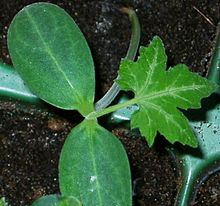
The endosperm develops nuclearly (through free nucleus division without cell formation). The young endosperm forms a haustorium towards Chalaza . This remains coenocytic (no cell formation, i.e. free cell nuclei) or later becomes cellular. The cells of the endosperm are partly highly polyploid in the later, cellular stage ; in Echinocystis lobata , 3072n was counted. In the mature seed, the endosperm is greatly reduced and largely degenerated. Often it only comprises two layers of cells.
Polyembryonia occasionally occurs in some species, several embryos are formed in one seed. In Hodgsonia macrocarpa (in the "stone core") it always occurs.
The seed coat is on cucurbits only from the outer integument formed of the ovule, the inner degenerate. From the outside in, it consists of an often three- layer epidermis , a hypodermis, a sclerenchyma , an aerenchyma and a chlorenchyma . This five-layer structure is characteristic of the family, some of which have been modified.
Successful fertilization is usually necessary for the fruit to develop. At the end of the growing season, however, the last flowers of many species can develop without fertilization if no flower of the plant has yet been fertilized. On the other hand, developing fruits often suppress the formation of further female flowers. The shape of the fruits, which is very variable in the cucurbits, is often pre-formed in the shape of the ovary.
Systematics


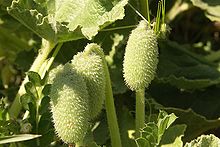
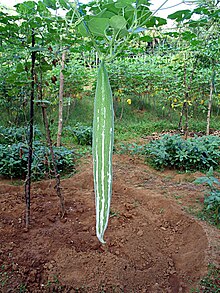

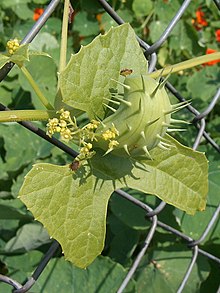
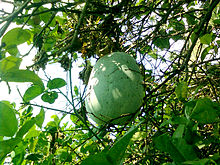
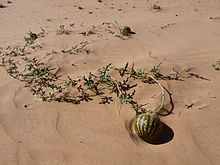

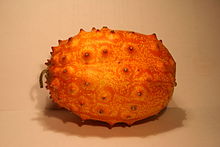


The family of the Cucurbitaceae was set up in 1789 by Antoine Laurent de Jussieu in Genera Plantarum , pages 393-394. Type genus is Cucurbita L. Synonyms for Cucurbitaceae Juss. nom. cons. are: Bryoniaceae G.Mey. , Nhandirobaceae T.Lestib. nom. illeg., Zanoniaceae Dumort. , Cyclantheraceae Lilja .
The closest related families of the pumpkin plants (Cucurbitaceae) within the order Cucurbitales are the begonia plants (Begoniaceae), pseudo hemp plants (Datiscaceae) and Tetramelaceae . The traditional systematics of the cucurbits is mainly based on characteristics of the androeceum , the gynoeceum , the tendrils, and since the middle of the 20th century also on the pollen structure and the structure of the seed coat. One of the most recent classifications of the family is that of C. Jeffrey (2005). The following list is taken from Kocyan et al. (2007), who expanded Jeffrey's system with new genera, so that the family includes 126 genera. Changes to cocyan, etc. are marked:
- Subfamily Nhandiroboideae ( Syn . : Zanonioideae)
- Tribe Zanonieae
- Subtribe Zanoniinae
-
Alsomitra (flower) M.Roem. : It contains only one type:
- Alsomitra macrocarpa (Blume) M.Roem. : It is common in tropical Asia in Thailand , Malaysia , Indonesia , New Guinea and the Philippines .
- Bayabusua W.J.de Wild (3 species on the Malay Peninsula )
- Gerrardanthus Harv. ex Benth. & Hook.f. (4 species in tropical and southern Africa)
- Neoalsomitra Hutch. (12 species in India , China , Polynesia, and Australia )
- Siolmatra Baill. : The only two species occur in the Amazon basin .
- Xerosicyos Humbert (2 to 3 species in Madagascar )
-
Zanonia L .: It contains only one species:
- Zanonia indica L .: It is common in India, Indochina , China, Malaysia and the Philippines.
- Zygosicyos Humbert : The only two species occur in Madagascar.
-
Alsomitra (flower) M.Roem. : It contains only one type:
- Subtribe Fevilleinae
- Fevillea L. (7 species in Central and tropical South America)
- Subtribe Gomphogyninae
- Gomphogyne handle. (1–2 species in China, Indochina, Malesia)
-
Gynostemma flower (5–13 species from India to Japan , Malaysia)
- Gynostemma pentaphyllum (Thunb.) Makino
- Hemsleya Cogn. ex FBForbes & Hemsl. (3–24 species in China ( Himalaya ))
- Actinostemmatinae subtribe
- Actinostemma handle. (1–3 species in Asia)
- Bolbostemma Franquet (2 types in China)
- Subtribe Sicydiinae
-
Chalema Dieterle : It contains only one species:
- Chalema synanthera Dieterle : It occurs in Mexico .
- Cyclantheropsis Harms (2–3 species in East Africa and Madagascar)
-
Pseudosicydium Harms : It contains only one species:
- Pseudosicydium acariianthum Harms : It occurs in Peru and Bolivia .
- Pteropepon (Cogn.) Cogn. (4 species in South America)
- Sicydium Schltdl. (6 species in Mexico, Central and Tropical South America)
-
Chalema Dieterle : It contains only one species:
- Subtribe Zanoniinae
- Tribe Zanonieae
- Subfamily Cucurbitoideae
- Tribe Joliffieae
- Telfairiinae subtribe
-
Odosicyos Keraudren : It contains only one species:
- Odosicyos bosseri Keraudren : It occurs in Madagascar.
- Telfairia Hook. (3 species in tropical Africa)
-
Odosicyos Keraudren : It contains only one species:
- Subtribe Thladianthinae
-
Baijiania A.M.Lu & JQLi : It contains only one species:
- Baijiania borneensis (Merr.) AMLu & JQLi : It occurs on Borneo .
-
Indofevillea Chatterjee : it contains only one species:
- Indofevillea khasiana Chatterjee : It occurs in India, Bhutan , Tibet and Nepal .
-
Microlagenaria (C. Jeffrey) AMLu & JQLi : It contains only one species:
- Microlagenaria africana (C.Jeffrey) AM Lu & JQLi : It occurs in Nigeria and Tanzania .
-
Bitter melons ( Momordica L. ) (47 species in Africa, tropical Asia, Australia and as a neophyte in the New World), including:
- Momordica balsamina L. (balsam apple, Jerusalem apple)
- Bitter melon ( Momordica charantia L. )
- Momordica cochinchinensis (Lour.) Spreng.
- Sinobaijiania C. Jeffrey & WJde Wilde (4 species in China, Indonesia , Taiwan, Thailand )
-
Siraitia Merr. (4 kinds in India, China, Thailand, Vietnam , Indonesia). Including:
- Siraitia grosvenorii (Swingle) AM Lu & Zhi Y. Zhang
-
Thladiantha Bunge (25 species in Asia)
- Thladiantha dubia Bunge : Central China to Manchuria and southern Mongolia to Korea, Sakhalin and the bordering Eastern Russia.
-
Baijiania A.M.Lu & JQLi : It contains only one species:
- Telfairiinae subtribe
- Tribe Bryonieae
- Austrobryonia H. Schaef . (4 species in Australia; first described in 2008)
- Fence beet ( Bryonia L. ) (10 types in the Mediterranean, North Africa and Central Asia)
-
Ecballium A.Rich. : It contains only one type:
- Splash cucumber ( Ecballium elaterium (L.) A.Rich. ): It is common in the Mediterranean, North Africa and Central Asia.
- Trichosantheae tribe
- Subtribe Ampelosicyinae
- Ampelosicyos Thouars (3 species in Madagascar)
-
Tricyclandra Keraudren : it contains only one species:
- Tricyclandra leandrii Keraudren : It occurs in Madagascar.
- Subtribe Hodgsoniinae
-
Hodgsonia Hook.f. & Thomson (2 species from Northeast India to Borneo )
- Hodgsonia macrocarpa (flower) Cogn. : Eastern Himalayas to Southeast Asia.
-
Hodgsonia Hook.f. & Thomson (2 species from Northeast India to Borneo )
- Subtribe Trichosanthinae
- Gymnopetalum Arn. (4 species in China, Indochina, India)
-
Trichosanthes L. (100 species in China, India, Malesia, Australia), including:
- Snake hair cucumber ( Trichosanthes cucumerina L. )
- Subtribe Ampelosicyinae
- Tribus Herpetospermeae
-
Biswarea Cogn. : It contains only one type:
- Biswarea tonglensis (CBClarke) Cogn. : It occurs in India, Myanmar and China.
-
Edgaria C.B. Clarke : It only contains one type:
- Edgaria darjeelingensis C.B.Clarke : it is, used in Inden Nepal and China.
-
Herpetospermum Wall. ex Benth. & Hook.f. : It contains only one type:
- Herpetospermum pedunculosum (Ser.) CBClarke : It occurs in Nepal, Tibet and China.
-
Biswarea Cogn. : It contains only one type:
- Tribe Schizopeponeae
- Schizopepon Maxim. (8 types in Russia , India, Myanmar, China, Japan)
- Tribe Luffeae
-
Luffa Mill. (7 species in Africa, Arabia, Asia, Australia, Central and South America), including:
- Sponge gourd ( Luffa cylindrica (L.) M. Roem. )
- Luffa operculata (L.) Cogn.
-
Luffa Mill. (7 species in Africa, Arabia, Asia, Australia, Central and South America), including:
- Tribe Sicyeae
- Subtribe Cyclantherinae
-
Brandegea Cogn. : It contains only one type:
- Brandegea bigelovii (S. Watson) Cogn. : This endemic occurs only in Baja California .
- Cyclanthera Schrad. (including Cremastopus Paul G.Wilson ) (25 species from North America to Argentina)
-
Echinocystis Torr. & A.Gray : It contains only one type:
- Spiky cucumber ( Echinocystis lobata (Michx.) Torr. & A.Gray ): It is common in North America and is a neophyte in Europe .
- Echinopepon Naudin (including Apatzingania Dieterle ) (18 species from Arizona to Argentina)
- Elateriopsis Ernst (5 species in Central to tropical South America)
- Hanburia Seem. (2 species in Mexico and Guatemala )
- Marah Kellogg (7 species in North America)
-
Pseudocyclanthera Mart. Crov. : It contains only one type:
- Pseudocyclanthera australis (Cogn.) Mart. Crov. : It occurs in Paraguay and Bolivia .
- Rytidostylis Hook. & Arn. (5 species in central to tropical South America)
-
Vaseyanthus Cogn. : It contains only one type:
- Vaseyanthus brandegeei (Cogn.) Rose : It occurs in Mexico.
-
Brandegea Cogn. : It contains only one type:
- Subtribe Sicyinae
- Microsechium Naudin (2 species in Mexico and Guatemala)
- Parasicyos Dieterle (2 species in Mexico and Guatemala)
- Sechiopsis Naudin ( incl.Pterosicyos Brandegee ) (5 species in Mexico and Guatemala)
- Sechium P. Brownne (11 species in Central America to tropical South America)
- Sicyos L. (50 species from North America to Argentina, Hawaii)
-
Sicyosperma A.Gray : It contains only one species:
- Sicyosperma gracile A.Gray : It is only found in Arizona .
- Subtribe Cyclantherinae
- Tribe Coniandreae
- Apodanthera Arn. (15 species in North and South America)
- Ceratosanthes Burm. ex Adans. (4 species in central to tropical South America)
- Corallocarpus Welw. ex Benth. & Hook.f. (17 species in Africa, Madagascar, India)
-
Cucurbitella Walp. : It contains only one type:
- Cucurbitella asperata (Gillies ex Hook. & Arn.) Walp. : It is common in South America.
-
Dendrosicyos Balf.f. : It contains only one type:
- Dendrosicyos socotrana Balf.f. : This endemic occurs only on the Socotra Archipelago.
- Dieterlea E.J. Lott (2 types in North America)
-
Doyerea Grosourdy : It contains only one species:
- Doyerea emetocathartica Grosourdy ex Bello : It is distributed from central to northern South America.
- Gurania (Schltdl.) Cogn. (35 species in central to tropical South America)
-
Guraniopsis Cogn. : It contains only one type:
- Guraniopsis longipedicellata Cogn. : It occurs in Peru .
-
Halosicyos Mart. Crov. : It contains only one type:
- Halosicyos ragonesei Mart. Crov. : It occurs in Argentina.
- Helmontia Cogn. (1 or 2 species in Guyana and Brazil)
- Ibervillea Greene (5 species in Texas , Mexico, Guatemala)
- Kedrostis med. (20 to 25 species in tropical and subtropical Africa, Madagascar, India, Sri Lanka , western Malesia)
-
Melothrianthus Mart. Crov. : It contains only one type:
- Melothrianthus smilacifolius (Cogn.) Mart. Crov. : It occurs in Brazil.
- Psiguria Neck. ex Arn. (12 species in central to tropical South America)
- Seyrigia Keraudren (4 species in Madagascar)
-
Trochomeriopsis Cogn. : It contains only one type:
- Trochomeriopsis diversifolia Cogn. : It occurs in Madagascar.
- Tumamoca Rose (2 species in North America and Mexico):
- Wilbrandia Silva Manso (5 species in South America)
- Tribe Benincaseae
- Subtribe Benincasinae
- Acanthosicyos Welw. ex Benth. & Hook.f. (2 species in southern Africa)
- Bambekea Cogn. (2 species in tropical Africa)
-
Benincasa Savi : It contains only one species:
- Wax gourd ( Benincasa hispida (Thunb.) Cogn. ): It is common in Asia and Australia.
-
Borneosicyos W.J.de Wilde : It contains only one species:
- Borneosicyos simplex W.J.de Wilde : It occurs in Indonesia and Sabah .
-
Cephalopentandra Chiov. : It contains only one type:
- Cephalopentandra ecirrhosa (Cogn.) C. Jeffrey : It is common in tropical and subtropical Africa.
- Citrullus Schrad. (3 species in tropical and subtropical Africa)
- Coccinia Wight & Arn. (30 species in tropical and subtropical Africa, Asia)
- Cogniauxia Baill. (2 species in tropical Africa)
- Ctenolepis Hook.f. (2 species in tropical and subtropical Africa, India)
- Dactyliandra (Hook.f.) Hook.f. (2 species in tropical and subtropical Africa, India)
- Diplocyclos (Endl.) Post & Kuntze (4 species in tropical and subtropical Africa, Asia)
- Eureiandra Hook.f. (8 species in tropical and subtropical Africa)
- Indomelothria W.J.de Wilde & Duyfjes (2 species in Southeast Asia)
-
Khmeriosicyos W.J.de Wilde & Duyfjes : It only contains one species:
- Khmeriosicyos harmandii W.J.de Wilde & Duyfjes : It only occurs in Cambodia .
-
Bottle gourds ( Lagenaria Ser. ) (6 species in tropical and subtropical Africa, Asia), including:
- Bottle gourd ( Lagenaria siceraria (Molina) Standley )
-
Lemurosicyos Keraudren : it contains only one species:
- Lemurosicyos variegata (Cogn.) Keraudren : It occurs in Madagascar.
- Neoachmandra W.J.de Wilde & Duyfjes (30 species in Africa, Australia, Pacific islands)
-
Nothoalsomitra I. Telford (1 species in tropical Australia):
- Nothoalsomitra suberosa (FMBailey) I. Telford
-
Papuasicyos Duyfjes : it contains only one species:
- Papuasicyos papuanus (Cogn.) Duyfjes : It occurs in Papua New Guinea.
- Peponium Engl. (20 species in tropical Africa, Madagascar)
-
Praecitrullus Pangalo : It contains only one species:
- Praecitrullus fistulosus (Stocks) Pangalo : It occurs in India and Pakistan.
- Raphidiocystis Hook.f. (5 species in tropical Africa, Madagascar)
- Ruthalicia C.Jeffrey (2 species in tropical Africa)
- Scopellaria W.J.de Wilde & Duyfjes (2 species in Southeast Asia)
- Solena Lour. (3 types in China, Indochina, India)
- Trochomeria Hook.f. (8 species in tropical and subtropical Africa)
- Urceodiscus W.J.de Wilde & Duyfjes (7 species in New Guinea)
-
Zombitsia Keraudren : It contains only one species:
- Zombitsia lucorum Keraudren : It occurs in Madagascar.
- Subtribe Cucumerinae
-
Cucumeropsis Naudin : it contains only one species:
- Cucumeropsis mannii Naudin : It is widespread in tropical Africa.
- Cucumber ( Cucumis L. ) (52 species in Africa, Madagascar, Asia to Northern Australia, including Cucumella . Chiov (11 species), Dicoelospermum C.B.Clarke (1 kind), Mukia . Arn (6 types), Myrmecosicyos C.Jeffrey (1 Species ) and Oreosyce Hook.f. (1 species), placed in 2007 to Cucumis )
-
Melancium Naudin : it contains only one type:
- Melancium campestre Naudin : It occurs in Brazil.
- Melothria L. (10 species in tropical Central and South America)
- Muellerargia Cogn. (2 species in Madagascar, Malaysia, Queensland)
-
Posadaea Cogn. : It contains only one type:
- Posadaea sphaerocarpa Cogn. : It is common in Central and South America.
- Zehneria Endl. (25 species in tropical and subtropical Africa, Madagascar, Asia)
-
Cucumeropsis Naudin : it contains only one species:
- Subtribe Benincasinae
- Tribe Cucurbiteae
-
Abobra Naudin : It contains only one species:
- Abobra tenuifolia (Gillies ex Hook. & Arn.) Cogn. : It is common in South America.
-
Anacaona Alain : It contains only one species:
- Anacaona sphaerica Alain : This endemic occurs only in the Dominican Republic.
- Calycophysum H. Karst. & Triana (5 species from Colombia to Bolivia)
- Cayaponia Silva Manso (60 species from North America to Argentina, West Africa, Madagascar)
- Cionosicys Griseb. (3 species in Central America, Jamaica )
- Pumpkins and zucchini ( Cucurbita L. ) (20 species from North America to Argentina)
-
Penelopeia Urb. : It contains only one type:
- Penelopeia suburceolata Urb. : This endemic occurs only in the Dominican Republic.
-
Peponopsis Naudin (1 species in Mexico):
- Peponopsis adhaerens Naudin
-
Polyclathra Bertol. (1 type from Mexico to Panama):
- Polyclathra cucumerina Bertol.
- Schizocarpum Schrad. (6 species in Mexico)
- Selysia Cogn. (4 species from Nicaragua to Peru)
-
Sicana Naudin (1 type from Mexico to Panama)
- Sicana odorifera Naudin
-
Tecunumania Standl. & Steyerm. (1 species in Central America):
- Tecunumania quetzalteca Standl. & Steyerm.
-
Abobra Naudin : It contains only one species:
- Tribe Joliffieae
This classification, based on morphological features, was essentially confirmed by Kocyan et al. 2007 in a phylogenetic study, which included 123 of the 130 genera, down to the tribe level, but the subtribes are artificial subdivisions. The following cladogram , simplified to the branches, can be derived from the work of Kocyan et al ., With wavy lines indicating branches that are paraphyletic with respect to the other branches of the same clad:
| Nhandiroboideae |
|
|||||||||||||||||||||||||||||||||||||||||||||||||||||||||||||||||||||||||||||||||||||||||||||||||||||||||||||||||||||||||||||||||||||||||||||||||||||||||||||||
|
|
||||||||||||||||||||||||||||||||||||||||||||||||||||||||||||||||||||||||||||||||||||||||||||||||||||||||||||||||||||||||||||||||||||||||||||||||||||||||||||||||
| Cucurbitoideae |
|
|||||||||||||||||||||||||||||||||||||||||||||||||||||||||||||||||||||||||||||||||||||||||||||||||||||||||||||||||||||||||||||||||||||||||||||||||||||||||||||||
|
|
Among the tribes recognized by Jeffrey in 2005, Jollifeae is highly polyphyletic . The genera of the Jollifeae form a group at the base of the Cucurbitoideae. Some genera of other tribes are classified within this group ( Cogniauxia from the Benincaseae, Ampelosicyos and Tricyclandra from the Trichosantheae). The remaining Trichosantheae form a group at the base of the Sicyeae. According to the results of Kocyan, some genera are among others para or polyphyletic.
use
| Harvest quantities and cultivation countries in 2014 | ||
|---|---|---|
| Art | Harvest (t) | most important growing countries |
| Watermelons | 111 million | China, Turkey, Iran, Brazil, Egypt |
| Cucumbers and pickles | 75 million | China, Russia, Iran, Turkey, Ukraine |
| Other melons (e.g. sugar melons) | 30 million | China, Turkey, Iran, Egypt, India |
| Pumpkins | 25 million | China, India, Russia, Ukraine, USA |
The use of the cucurbits by humans is very diverse. The fruits are harvested ripe or unripe and baked ( pumpkins ), deep-fried ( bitter melon ), boiled ( wax gourd , snake- haired cucumber ), stuffed ( Cyclanthera pedata ), pickled ( cucumber ), candied ( watermelon , wax gourd, Cucurbita ficifolia ) or fresh as a salad ( Cucumber) or dessert ( sugar melon, watermelon). To preserve them, they can be processed into preserves, frozen or pickled. The fruit juice of some types is fermented into alcoholic beverages; in Japan, for example, sugar melon is used to make liqueur.
The seeds are very nutritious because of their high oil content. In Africa, the seeds of watermelon, naras and other species can make up an essential part of the diet. In Mexico and Central America, but also in parts of Central and Southeastern Europe, pumpkin seeds are eaten as a snack. The selection of "naked", ie thin-skinned, seeds has also increased its popularity in other countries. The seeds of the following species are used to produce oil as food, for lighting, for making soap and others: garden pumpkin (including the Styrian oil pumpkin), watermelon, loofah , Fevillea cordifolia , Hodgsonia spp. and Cucumeropsis mannii . In addition to fruits and seeds, flowers, leaves, shoot tips and roots ( chayote ) are also prepared.
The fruits of the bottle gourd are hollowed out to make storage vessels, bottles, but also tobacco pipes, musical instruments, penis cases, masks, buoys for fishing nets, baby rattles, etc. The fruits of the wax gourd and various types of cucurbita are also used as storage vessels. The sponge gourd and momordica angustisepala are used as a sponge.
The medicinal use of the cucurbits, which has been documented since ancient times, is extremely varied, both in terms of the species used and the areas of application. In their tabular overview focused on India, Guha and Sen indicate 79 areas of application. It is widely used as a laxative , emetic, and worming agent . The effect is mostly due to the content of cucurbitacins . The roots of Trichosanthes dioica are used as a poison.
supporting documents
The article is mainly based on the following sources:
- The family of Cucurbitaceae in APWebsite . (engl.)
literature
- Alexander Kocyan, Li-Bing Zhang, Hanno Schaefer, Susanne S. Renner : A multi-locus chloroplast phylogeny for the Cucurbitaceae and its implications for character evolution and classification. In: Molecular Phylogenetics and Evolution. Volume 44, August 2007, pp. 553-577. doi: 10.1016 / j.ympev.2006.12.022 , full text (systematics; PDF; 381 kB)
- RW Robinson, DS Decker-Walters: Cucurbits. CAB International, Wallingford 1997, ISBN 0-85199-133-5 . (Characteristics, growth and development, use)
- NM Nayar, TA More: Cucurbits. Science Publishers, Enfield 1998, ISBN 1-57808-003-7 .
Individual evidence
- ↑ a b c Alexander Kocyan, Li-Bing Zhang, Hanno Schaefer, Susanne S. Renner : A multi-locus chloroplast phylogeny for the Cucurbitaceae and its implications for character evolution and classification. In: Molecular Phylogenetics and Evolution. Volume 44, August 2007, pp. 553-577.
- ↑ a b This section is mainly based on: Kocyan, Zhang, Schaefer, Renner: A multi-locus chloroplast phylogeny for the Cucurbitaceae and its implications for character evolution and classification. In: Molecular Phylogenetics and Evolution. Volume 44, August 2007, pp. 553-577.
- ↑ L.-B. Zhang, MP Simmons, A. Kocyan, SS Renner: Phylogeny of the Cucurbitales based on DNA sequences of nine loci from three genomes: Implications for morphological and sexual system evolution. In: Molecular Phylogenetics and Evolution. Volume 39, 2006, pp. 305-322. doi: 10.1016 / j.ympev.2005.10.002
- ↑ a b c d e f g h J. Guha, SP Sen: Physiology, biochemistry and medicinal importance. In: NM Nayar, TA More: Cucurbits. Science Publishers, Enfield 1998, ISBN 1-57808-003-7 , pp. 97-127.
- ↑ PKK Nair, R. Satheesh: Palynology. In: NM Nayar, TA More: Cucurbits. Science Publishers, Enfield 1998, ISBN 1-57808-003-7 , pp. 85-95.
- ↑ 2007 - Joe Jutras and his 1689 pound World Record! www.bigpumpkins.com
- ↑ Susanne S. Renner, Hanno Schaefer, Alexander Kocyan: Phylogenetics of Cucumis (Cucurbitaceae): Cucumber (C. sativus) belongs in an Asian / Australian clade far from melon (C. melo). In: BMC Evolutionary Biology. No. 7, 2007, p. 58. doi: 10.1186 / 1471-2148-7-58 , (full text; pdf; 391 kB)
- ↑ a b c Dietrich Frohne, Uwe Jensen: Systematics of the plant kingdom with special consideration of chemical characteristics and plant drugs . 4th revised edition. Gustav Fischer, Stuttgart / Jena / New York 1992, ISBN 3-437-20486-6 .
- ↑ Li-Bing Zhang, Mark P. Simmons, Alexander Kocyan, Susanne S. Renner : Phylogeny of the Cucurbitales based on DNA sequences of nine loci from three genomes: Implications for morphological and sexual system evolution. In: Molecular Phylogenetics and Evolution. Volume 39, 2006, pp. 305-322. doi: 10.1016 / j.ympev.2005.10.002
- ^ Charles Jeffrey: A new System of Cucurbitaceae. In: Botanicheskii Zhurnal. Volume 90, 2005, pp. 332-335.
- ↑ Josef Domes: Momordica treatise. In: Author's Lexicon , VI, Sp. 645 f.
- ↑ Josef Domes, Gundolf Keil : The 'Momordica' or 'Balsam Oil Treatise'. An example of the transfer of indications from oil to the apple of Jerusalem. In: Gundolf Keil (Ed.): “Make a teutsch bad luck”. Investigations into the local language teaching of medical knowledge. (= Ortolf studies. 1; = Knowledge literature in the Middle Ages. 11). Reichert, Wiesbaden 1993, ISBN 3-88226-539-6 , pp. 480-498.
- ^ Hanno Schaefer, Ian RH Telford, Susanne S. Renner : Austrobryonia (Cucurbitaceae), a New Australian Endemic Genus, is the Closest Living Relative to the Eurasian and Mediterranean Bryonia and Ecballium. In: Systematic Botany. Volume 33, 2008, pp. 125-132. (Full text; pdf; 456 kB)
- ↑ Hanno Schaefer: Cucumis (Cucurbitaceae) must include Cucumella, Dicoelospermum, Mukia, Myrmecosicyos, and Oreosyce: a recircumscription based on nuclear and plastid DNA data. In: Blumea. Volume 52, 2007, pp. 165-177. (on-line)
- ↑ to: FAOSTAT harvest statistics , data for “watermelons”, “cucumbers and gherkins”, “other melons (inc. Cantaloupes)”, “pumpkins, squash and gourds”, accessed November 1, 2017.
- ^ RW Robinson, DS Decker-Walters: Cucurbits. CAB International, Wallingford 1997, ISBN 0-85199-133-5 , p. 26.
Web links
- Information on the Cucurbitaceae family from TCAndres. ( Memento from October 28, 2011 in the Internet Archive )
further reading
- Amanuel G. Ghebretinsae, Mats Thulin, Janet C. Barber: Relationships of cucumbers and melons unraveled: molecular phylogenetics of Cucumis and related genera (Benincaseae, Cucurbitaceae). In: American Journal of Botany. Volume 94, Issue 7, 2007, pp. 1256-1266. doi: 10.3732 / ajb.94.7.1256







